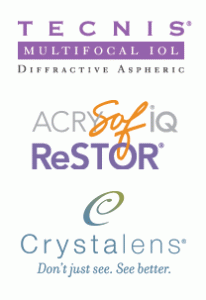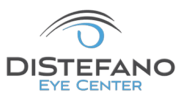Cataract Replacement Lens Options
Intraocular implants have been used for many years. Originally, IOCs were monofocal—they could be focused to provide clear vision for near distances or for far distances, but normally not both. Eyeglasses were used to compensate.
As technology improved, however, IOCs became more sophisticated. Multifocal IOCs function much like the eye’s natural lens—they can adjust focus to that the patient can see at all distances: These monofocal implants are designed to provide clearer vision at either distance or near, but, typically not both. Eyeglasses may be necessary to correct vision at all ranges: distance, intermediate, and near.
Today, premium IOCs offer a variety of patient benefits. DiStefano Eye Center offers the top brands in premium IOCs, including:
 Tecnis® multifocal lens – The advanced TECNIS® Multifocal is an implantable lens that restores vision after cataract surgery and corrects presbyopia (the need for reading glasses). It delivers results superior to those of a standard multifocal lens and offers an excellent chance to become spectacle independent.
Tecnis® multifocal lens – The advanced TECNIS® Multifocal is an implantable lens that restores vision after cataract surgery and corrects presbyopia (the need for reading glasses). It delivers results superior to those of a standard multifocal lens and offers an excellent chance to become spectacle independent.
Acrysof® IQ ReSTOR® IOL – For most patients this implantable lens delvers excellent near, intermediate and distance vision, potentially without the need for reading glasses or bifocals in a variety of lighting conditions.
Crystalens® accommodating intraocular lens – the first presbyopia correcting IOL introduced into the United States market and is currently the only FDA-approved accommodating IOL.
The accommodative IOL is a third type of replacement lens. It has a hinge designed to work with your eye muscles, allowing the lens to move forward as the eye focuses on near objects and backward as the eye focuses on distant objects. This movement allows you to focus clearly at different distances.
Implanting an IOL takes about 20 minutes and is an outpatient procedure. In addition to a preoperative eye exam, your eye surgeon will take some measurements of your eyes and will give you topical or local anesthesia. The surgeon makes a few small incisions close to the edge of the cornea and then inserts a small ultrasound instrument to break up the center of the eye’s natural lens. The lens is then vacuumed out through one of the incisions. The surgeon folds and inserts the IOL through the same incision. These incisions are usually self-sealing, requiring no stitches. Once implanted, a multifocal or accomodative IOL allows you to focus on near or distant objects.
Risks associated with implanting IOL’s include overcorrection or under-correction, infection, increased floaters, retinal detachment, dislocation of the implant, halos, glare, dry eye, decreased contrast sensitivity, clouding of a portion of the IOL, and loss of vision.
If you are going to have cataract surgery, you and your ophthalmologist at DiStefano Eye Center should discuss which IOL may be best for your vision needs. We will help you understand all of your options and make a choice that reflects your physical condition and lifestyle choices.
For an appointment, call DiStefano Eye Center at (423) 648-3937. Or Click Here to contact us online.
LASIK surgery changed my life. I'm more productive and more active than ever. I wish I'd done it sooner. Dr. Distefano and her staff were amazing!
Roger L.Appointments
Schedule an appointment at either of our offices.



